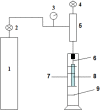Preparation and preliminary dialysis performance research of polyvinylidene fluoride hollow fiber membranes
- PMID: 25807890
- PMCID: PMC4384094
- DOI: 10.3390/membranes5010120
Preparation and preliminary dialysis performance research of polyvinylidene fluoride hollow fiber membranes
Abstract
In this study, the separation properties of Polyvinylidene fluoride (PVDF) hollow fiber hemodialysis membranes were improved by optimizing membrane morphology and structure. The results showed that the PVDF membrane had better mechanical and separation properties than Fresenius Polysulfone High-Flux (F60S) membrane. The PVDF membrane tensile stress at break, tensile elongation and bursting pressure were 11.3 MPa, 395% and 0.625 MPa, respectively. Ultrafiltration (UF) flux of pure water reached 108.2 L∙h-1∙m-2 and rejection of Albumin from bovine serum was 82.3%. The PVDF dialyzers were prepared by centrifugal casting. The influences of membrane area and simulate fluid flow rate on dialysis performance were investigated. The results showed that the clearance rate of urea and Lysozyme (LZM) were improved with increasing membrane area and fluid flow rate while the rejection of albumin from bovine serum (BSA) had little influence. The high-flux PVDF dialyzer UF coefficient reached 62.6 mL/h/mmHg. The PVDF dialyzer with membrane area 0.69 m2 has the highest clearance rate to LZM and urea. The clearance rate of LZM was 66.8% and urea was 87.7%.
Figures











Similar articles
-
Research on polyvinylidene fluoride (PVDF) hollow-fiber hemodialyzer.Biomed Tech (Berl). 2016 Jun 1;61(3):309-16. doi: 10.1515/bmt-2014-0190. Biomed Tech (Berl). 2016. PMID: 25781663
-
Flux and Passage Enhancement in Hemodialysis by Incorporating Compound Additive into PVDF Polymer Matrix.Membranes (Basel). 2016 Oct 19;6(4):45. doi: 10.3390/membranes6040045. Membranes (Basel). 2016. PMID: 27775566 Free PMC article.
-
Preparation of Polyvinylidene Fluoride (PVDF) Hollow Fiber Hemodialysis Membranes.Membranes (Basel). 2014 Feb 27;4(1):81-95. doi: 10.3390/membranes4010081. Membranes (Basel). 2014. PMID: 24957122 Free PMC article.
-
A Review of Commercial Developments and Recent Laboratory Research of Dialyzers and Membranes for Hemodialysis Application.Membranes (Basel). 2021 Oct 7;11(10):767. doi: 10.3390/membranes11100767. Membranes (Basel). 2021. PMID: 34677533 Free PMC article. Review.
-
Fluid and solute transfer characteristics in a dialyzer with a high-performance membrane.Contrib Nephrol. 2011;173:103-109. doi: 10.1159/000328948. Epub 2011 Aug 8. Contrib Nephrol. 2011. PMID: 21865782 Review.
Cited by
-
Oxone®-Mediated TEMPO-Oxidized Cellulose Nanomaterial Ultrafiltration and Dialysis Mixed-Matrix Hollow Fiber Membranes.Polymers (Basel). 2020 Jun 15;12(6):1348. doi: 10.3390/polym12061348. Polymers (Basel). 2020. PMID: 32549325 Free PMC article.
-
Membranes for the life sciences and their future roles in medicine.Chin J Chem Eng. 2022 Sep;49:1-20. doi: 10.1016/j.cjche.2022.04.027. Epub 2022 Jun 15. Chin J Chem Eng. 2022. PMID: 35755178 Free PMC article. Review.
-
Gas Permeability and Mechanical Properties of Polyurethane-Based Membranes for Blood Oxygenators.Membranes (Basel). 2022 Aug 24;12(9):826. doi: 10.3390/membranes12090826. Membranes (Basel). 2022. PMID: 36135845 Free PMC article.
References
-
- Li L.L., Cheng C., Xiang T., Tang M., Zhao W., Sun S., Zhao C. Modification of polyethersulfone hemodialysis membrane by blending citric acid grafted polyurethane and its anticoagulant activity. J. Membr. Sci. 2012;405–406:261–274. doi: 10.1016/j.memsci.2012.03.015. - DOI
-
- Zhao C.S., Liu T., Lu Z.P., Cheng L.P., Huang J. An evaluation of polyethersulfone hollow fiber plasma separator by animal experiments. Artif. Org. 2001;25:60–63. - PubMed
-
- Zhao C.S., Liu X.D., Nomizu M., Nishi N. Blood compatible aspects of DNA-modified polysulfone membrane—Protein adsorption and platelet adhesion. Biomaterials. 2003;24:3957–3755. - PubMed
LinkOut - more resources
Full Text Sources
Other Literature Sources

